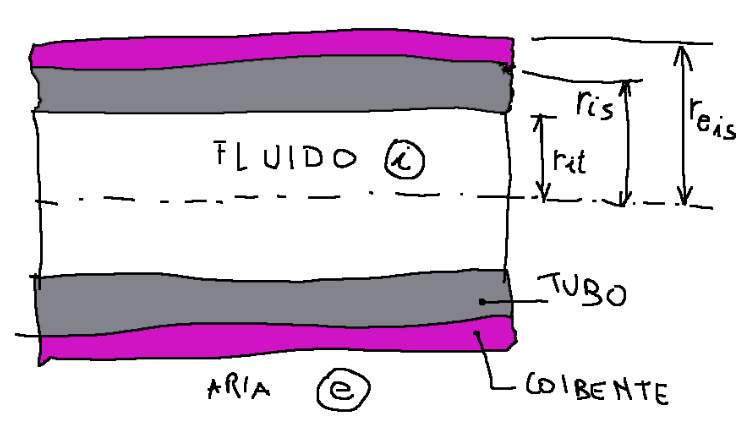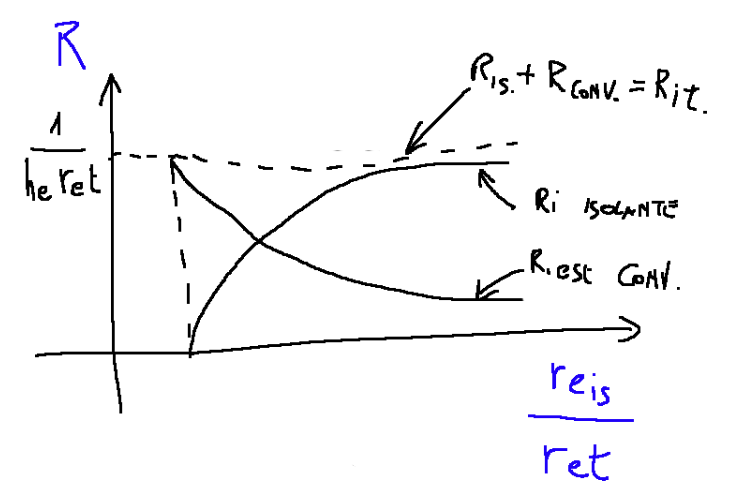
~~~ La versione in italiano inizia subito dopo la versione in inglese ~~~
ENGLISH
11-02-2024 - Physics - An insulator and its insulating power [EN]-[IT]
Basic concepts
In thermodynamics the study of gases is a fundamental part.
Below I report the equation of state for ideal gases.
p V = n R T
Where:
p = pressure
V = volume
n = number of moles
R = ideal gas constant (8314 Pa m3 / kmol °K)
V = volume
Remember that the specific heat at constant volume depends on the gas
To fully describe the behavior of a system it is necessary to have two equations as there are two degrees of freedom in the system itself which are u and v.
The equation of state of ideal gases is

Where:
-u = internal energy of the system
-cv is a constant that depends on the gas and is called the specific heat of the gas at constant volume.
-T is the temperature.
The fundamental relation for ideal gases is

An insulator and the insulating power
Below is the diagram of a section of a pipe with its external insulation.
The insulator has the task of generating a resistance that is lower than the dissipation of the tube without sheath.

Where:
r e is = external insulating radius
r et = tube external radius = r i is = insulating internal radius
r it = internal radius of the tube
The total resistance is equal to the insulation resistance + the convective resistance

Therefore, around the pipe the insulation generates a resistivity, but also ensures that the exchange surface of the pipe increases. This situation could generate a different effect from what we would actually like to achieve with the insulation layer.
It will therefore be important to choose an insulating material whose thickness is not less than a minimum threshold. This minimum threshold is called the critical isolation radius (r c)
Let's now look at the following graph with the ratio r and is on the abscissae and R on the ordinate.

From here we can see that
-the Ris graph starts with zero ordinate and its curve has a downward concavity.
-the Rest graph. conv. it starts from an ordinate value equal to 1/h and r et and decreases hyperbolically as r and is / r et increases.
As a final consideration we can say that r c is that value of r e is which makes R t minimal, therefore we will have the following formula.
Conclusions
In the case of a pipe insulated on the outside, to have good insulation it is necessary to choose a material whose thickness is not less than a minimum threshold, called the critical insulation radius.
Request
Did you know that under certain conditions the insulation of a pipe may not perform its insulation function well?

11-02-2024 - Fisica - Un coibentante ed il potere isolante [EN]-[IT]
Concetti base
Nella termodinamica lo studio dei gas è una parte fondamentale.
Qui sotto riporto l’equazione di stato per i gas perfetti.
p V = n R T
dove:
p = pressione
V = volume
n = numero di moli
R = costante dei gas perfetti (8314 Pa m3 / kmol °K)
V = volume
Ricordiamo che il calore specifico a volume costante dipende dal gas
Per descrivere compiutamente il comportamento di un sistema è necessario avere due equazioni in quanto ci sono due gradi di libertà nel sistema stesso che sono u e v.
L'equazione di stato dei gas perfetti è

dove:
-u = energia interna del sistema
-cv è una costante che dipende dal gas ed è detta calore specifico del gas a volume costante.
-T è la temperatura.
La relazione fondamentale per i gas perfetti è

Un coibentante ed il potere isolante
Qui sotto è presente lo schema di una sezione di un tubo con il suo coibentante esterno.
L’isolante ha il compito di generare una resistenza che risulti inferiore alla dissipazione del tubo senza guaina.

Dove:
r e is = raggio esterno isolante
r et = raggio esterno tubo = r i is = raggio interno isolante
r it = raggio interno tubo
La resistenza totale risulta uguale alla resistenza dell’isolante + la resistenza convettiva

Quindi intorno al tubo l’isolante genera una resistività, ma fa anche in modo che la superficie di scambio del tubo aumenti. Questa situazione potrebbe generare un effetto diverso da quello che effettivamente vorremmo ottenere con lo strato di isolante.
Sarà importante quindi scegliere un coibentante il cui spessore non sia inferiore ad una soglia minima. Questa soglia minima è chiamata raggio critico di isolamento (r c)
Diamo ora un’occhiata al seguente grafico con il rapporto r e is sulle ascisse e R sulle ordinate.

Da qui possiamo vedere che
-il grafico Ris inizia con ordinata nulla e la sua curva ha la concavità verso il basso.
-il grafico di Rest. conv. parte da un valore di ordinata uguale a 1/he r et e decresce iperbolicamente all’aumentare di r e is / r et.
Come considerazione finale possiamo dire che r c è quel valore di r e is che rende minima R t, perciò avremo la seguente formula.
Conclusioni
Nel caso di un tubo coibentato all'esterno, per avere un buon isolamento occorre scegliere un materiale il cui spessore non sia inferiore ad una soglia minima, detta raggio critico di isolamento.
Domanda
Lo sapevate che in certe condizioni il coibentante di un tubo potrebbe non svolgere bene la sua funzione di isolamento?
THE END